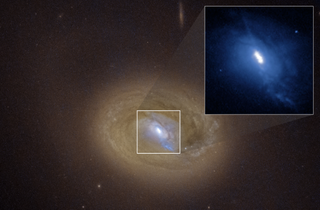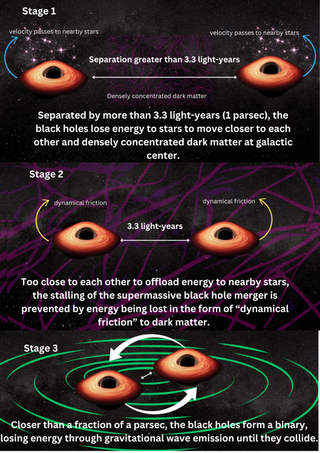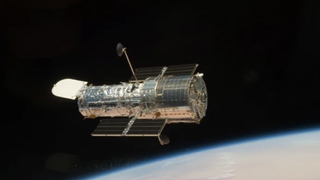These 2 black monsters may be the closest two ever found in visible and X-ray light (video)
It’s the ultimate telescope vs. supermassive black hole tag team as NASA’s Chandra and Hubble teams squeeze the supermassive black hole! Not only was this group of black holes incredibly close to Earth, but they were also very close!
The supermassive black holes are located in the merging star cluster MCG-03-34-64, about 800 million light-years across, and separated by 300 light-years.
That’s not all. These two black holes destroy gas and dust falling on them from their surroundings, fueling bright emissions and powerful jets. Such regions are called “active galactic nuclei” or “AGNs,” and they can often be so bright that they outshine the combined light of every star in the surrounding galaxies.

Despite being almost incomprehensible from Earth, this pair is still the closest AGN seen at most wavelengths of light. Hubble saw it in visible light, and Chandra saw it in X-rays. Two nearby supermassive holes were discovered, but they were only detected by radio waves and have not been confirmed at other wavelengths, according to NASA.
The supermassive black holes at the heart of MCG-03-34-64 are also much closer than previously discovered binaries of this type. Both would have been at the centers of their respective galaxies at the same time, with the collisions and mergers of those galaxies bringing them closer together.
Two supermassive black holes can’t stay this far apart, either. As they orbit, the binaries will produce periodic waves called “gravitational waves.” As these gravitational waves spin through space, they pick up angular momentum away from the black holes, causing them to pull together and emit faster and faster gravitational waves.
This will continue for about 100 million years until the supermassive black holes become so close together that their gravitational pull becomes stronger, and they are forced to collide and merge as their galaxies do. ever did.
Related: Small black holes could play ‘hide-and-seek’ with invisible pairs of black holes

AGN binaries like this one are thought to have been common in the early universe billions of years ago when galaxy mergers were common. This merger provides a unique opportunity to observe such a binary that is much closer to home than it was billions of years ago, so it is billions of light years away.
Hubble is lucky
This discovery is an example of how silence can play a role in astronomy. Hubble spotted an AGN in the data showing dense oxygen in the very small region of MCG-03-34-64.
“We didn’t expect to see something like this,” team leader Anna Trindade Falcão of the Center for Astrophysics| Harvard & Smithsonian said in a statement. “This sight is unusual in the nearby universe, and it tells us that something else is going on in the galaxy.”
To solve the mystery of what is happening in MCG-03-34-64, Falcão and colleagues turned to Chandra to examine the same area, this time using X-rays.
“Looking at MCG-03-34-64 in the X-ray cluster, we saw two separate, intense sources of high-energy emission consistent with the bright light features seen with Hubble,” Falcão continued. “We put these pieces together and decided that we were probably looking at two very large, very large holes.”

The group did not stop there. They wrote about some help for this group of space telescopes in the form of data from the Karl G. Jansky Very Large Array (VLA) near Socorro, New Mexico. This revealed that the supermassive black holes at the heart of this AGn are also emitting strong radio waves.
Falcão continued, “When you see bright light with optical radiation, X-rays and radio waves, many things can be excluded, and this can only be described as black holes he is near.” “When you put all the pieces together, you get a picture of the AGN duo.”
Hubble spotted a third bright source of light in the AGN, which remains a mystery. The team suggests that this may be gas “stirred up” by a high-speed plasma jet produced by one of the supermassive black holes, which is roughly the same as a jet of water from a garden hose blasting a sand dune.
Studies prove that even after three decades in space, Hubble is still providing the latest scientific results.
“We would not have been able to see these complex objects without the incredible resolution of Hubble,” Falcão concluded.
The team’s research was published Monday (Sept. 9) in The Astrophysical Journal.
#black #monsters #closest #visible #Xray #light #video